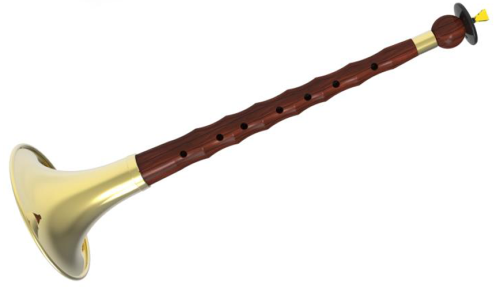1 / 3
Premium Chinese traditional music instrument Suona
| Model No. : | LY-DS-WG-01 |
|---|

Product description
Known for its extremely loud sound and distinctively Northern flavour, the Chinese suona is a military instrument that has the ability to instinctively take the lead of all other instruments when played. Commonly known in Asia not as a military instrument but more for its use at weddings and funeral processions, some have naturally associated the instrument`s blasting of sound with good luck, the ability to chase evil spirits away and to generally usher in festivities. Aside from its military role, this Chinese trumpet was also typically used day-to-day. Some musicians claim that the Chinese suona traces its roots back to India, where numerous Indian trumpets bear resemblance to it. Today, the suona can refer to different trumpets that span across multiple registers. The largest suonas can be up to five chi (one chi being the equivalent of one third of a metre), while the smallest suonas can only measure up to a few inches long. Thus, suonas can be categorized into two broad categories based on size. The modern Chinese orchestra uses both the traditional suona as well as reformed suonas, which help fill in inadequacies in range that are unattainable using the traditional ones. Just like the dizi and the traditional sheng, the suona is not produced in a standard key. As a highly traditional instrument, a single soprano suona is not able to execute pieces with a myriad of key changes. Thus, like dizi performers, most suona musicians bring more than one instrument along for performances with an orchestra. Just like the sheng, the traditional suona has been reformed to produce variants such as the alto suona, tenor suona and bass suona. These instruments are capable of producing notes in lower registers. Nevertheless, unlike the sheng, the traditional suona is used alongside the reformed suona in the Chinese orchestra. The Hong Kong Chinese Orchestra has a series of videos that introduce the suona and the guan. Check them out.
The suona is a double-reed aerophone, or shawm, of China. In northern China the suona, often referred to by the name laba, is central to village chuida (`blowing-hitting`) ensembles. These ensembles are exclusively male and often familial organizations. Chuida musicians, and by association the suona, are viewed as lower-class professionals. Performance settings include calendric rituals like New Year and harvest festivals and birthdays of gods; life-cycle rituals such as weddings and funerals; and other ritual occurrences. The suona is found in many other parts of China as well where it is an indispensable member of many regional types of outdoor ensembles. Additionally, it is used in Beijing opera for martial scenes, and has in recent decades been introduced into the evolving modern Chinese orchestra tradition.
Description
Three suona are pictured in the image gallery of this page; the first two are approximately the same length, the third considerably shorter and goes by the names `haidi` and `aizai.` All have a scalloped body made out of a hardwood such as redwood, a conical bore, seven fingerholes and, on the reverse side (see Detail image), one thumbhole, and a loosely-attached flaring metal (usually brass) bell. At the top end of the body there is a staple (a tapering metal tube) that on two of the specimens is ornamented with metal spheres and discs. Just below the open end of the staple is a firmly attached disc or pirouette. A relatively small double reed caps off the exposed end of the staple. The reed is made from folded and cut river reed bound together with copper wire.
Player - Instrument Interface and Sound Production
A suona player holds the instrument in front of himself with both hands. He completely encloses the reed in his mouth without touching it, his lips pressed firmly against the pirouette. A great deal of air pressure is required to activate of the double reed, and it is not uncommon for players to utilize the circular breathing technique while playing this instrument. The concussion action of the reeds allows rapid bursts of energy into the air column of the instrument to produce various modes of pressure waves that we hear as sound. The active acoustical length of the air column at any given instant is determined by which finger/thumbholes are covered. The player can also overblow many fingering combinations to sound the first or second harmonic partial overtone above a fundamental. The range of the suona is given variously as from one-and-a-half to just over two octaves; Liang (p. 270) presents its range as A4 to B6. The haidi/aizai range would certainly differ considerably from that of the two longer suona, perhaps by as much as an octave. Players frequently produce bends and other sorts of pitch inflections when playing the suona through manipulating the airstream and with special fingering techniques. This instrument is generally played at full volume to produce a penetrating sound, perfect for outdoor performance.
Origins/History/Evolution
Pictorial evidence suggests that early forms of the suona entered northwestern China from Central Asia via the Silk Road starting in the 3rd century CE. The word `suona` is derived from the Arabic word `zurna` (`oboe`). It was well established in China by the Yuan dynasty (1279-1368 CE) and much of the repertoire can be dated to the 13th and 14th centuries. During the early decades of the Peoples Republic of China (established in 1949) and especially during the Cultural Revolution (the 1970s) ideology brought about the cessation of much of the ritual life in China, but the suona has seen a revival in ritual usage since the 1980s.
Send your inquiry to this supplier













